Only have 2 days in Kyoto? We’ve got you covered.
Kyoto is arguably Japan’s most beautiful city and has many attractions to share – from ancient shrines and temples, to serene gardens and vibrant food markets. Of course many people visit Kyoto to see the cherry blossoms in spring and to admire the enchanting geisha and maiko who gracefully continue centuries old traditions among the chaos of this modern city.
We’ve prepared a fast paced itinerary to help you cover all the highlights plus a few surprises along the way. As with all our published guides, this Kyoto two day itinerary has been refined from the trip we took and optimized for timing and travel times based on our experience.
In this guide we give you instructions for getting to and from each place you visit. You will also find accommodation and tour recommendations in this article.
The cultural and historic center of Japan, Kyoto is known for its ancient culture, period buildings and beautiful gardens. No fewer than 17 sites in the city are listed on UNESCO’s world heritage list in recognition of the central role the city played as the imperial capital of Japan for over 1,000 years.
The city is home to over 1,600 Buddhist temples and 400 Shinto shrines, so visiting several is an important part of your itinerary. If you are a fan of Japanese garden design and nature there are stops in here for you too.
Most of the travel within Kyoto can be done by walking, subway or taxi. There are some points where a bus is an option too. There is information on getting around Kyoto at the end of the article.
1.DAY ONE
08:00 FUSHIMI INARI SHINE
Fushimi Inari information
Cost: Free
Hours: Open 24/7
Address: 68 Yabunouchi-cho, Fukakusa Fushimi-ku, Kyoto
Transport: Inari Station [JR Nara line] or Fushimi-Inari Station [Meihan main line]
Next stop Nishiki Market – take the Keihan main line subway from Fushimi-Inari station to Gion Shijo station and walk 10 minutes to the market
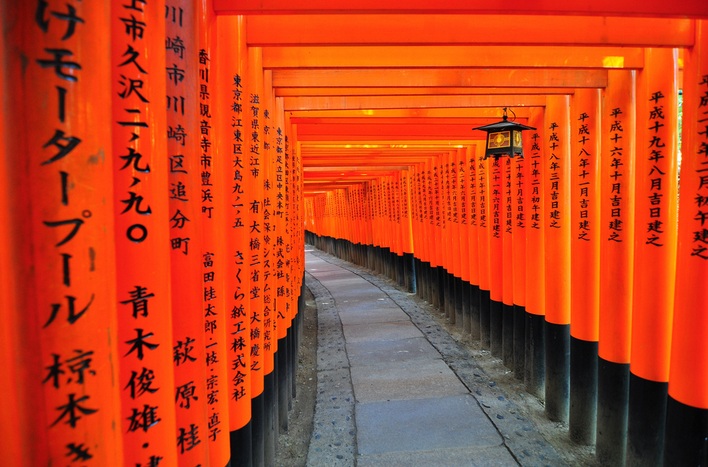
Start your day early with a visit to Fushimi Inari shrine. This famous Shinto shrine, is known for its impressive vermilion torii gates that wind their way up Mount Inari. It is one of the most popular places to visit in Japan so get there as early as possible to avoid the crowds.
Thousands of gates line 4 kilometers of trails from the main 5 shrines at the base of the mountain. Most visitors don’t venture too far past the main shrine so if you want the best photos continue walking up the mountain. You can stop at some of the charming sub shrines along the way. The hike to the top is worth it for stunning views of Kyoto and is a 2-3 hour return journey.
Fushimi Inari was dedicated to the gods of rice and sake in the 8th century. Notice the many stone statues of foxes (the messenger of the god Inari) during your visit. You can also buy small Ema or tablets in the shape of a fox for 500Y to write your wish and leave it at the shrine.
See also: FUSHIMI INARI SHRINE GUIDELINE 2020
10:30 NISHIKI MARKET
Nishiki market information
Cost: Free
Hours: Open daily 09:00 – 17:00 with some stalls closed on Wednesdays
Address: Nishikikoji-dori, Nakagyo-ku (between Teramachi and Takakura)
Transport: Shijo Station [Karasuma subway line] or Karasuma or Kawaramachi Station [Hankyu line]
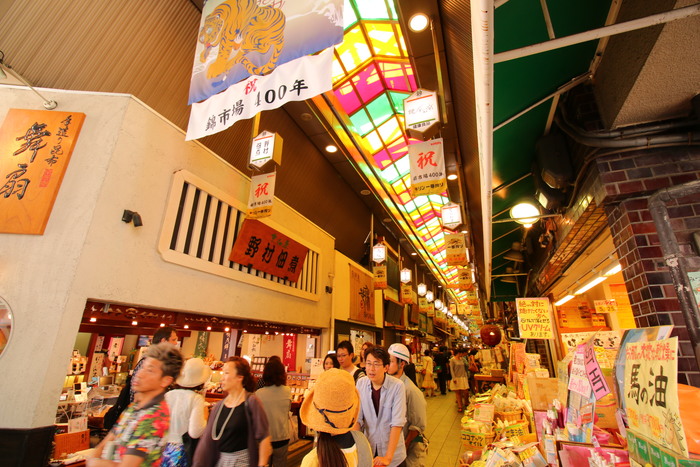
The Nishiki market is known to locals as ‘Kyoto’s pantry’ and features many stalls where you can try the traditional cuisine of the city. Take a food tour or explore on your own, either way it’s a fun way to enjoy the local culture.
From the strange looking vegetables and yakitori sticks, to sashimi and wagyu beef, you can fill your belly at Nishiki market. Question is, will you try the Tako Tamago – baby octopus on a stick? Its head is stuffed with a quail egg! We gave it a miss and devoured okomiyaki and mochi instead
We did a food tour and it was a great idea. You can browse the stalls on your own but a guide will help you navigate the market, show you the best stalls and help you choose the food you wish to try.
See also: WHAT TO EAT AT THE NISHIKI MARKET?
14:00 SHRINES AND TEMPLES OF GION OR NIJO CASTLE
After your food experience it’s time to keep moving and explore more of Kyoto. Depending on your interests you may like to visit the shrines of the Gion area or explore the Edo era Nijo Castle where scenes from The Last Samurai were filmed.
ROUTE 1 – TEMPLES AND SHRINES OF GION
The Gion area is home to some of the most important temples and shrines in Kyoto, each with its own special charm. If you head to Shōren-in Monzeki temple you can make your way down to the Yasaka shrine with a stop at the imposing Chion-in temple on the way.
A beautiful and serene series of buildings set in tranquil gardens, Shōren-in temple dates back to the 12th century and has strong connections to the imperial family. Admire the historic structures including an elegant tea room and take a stroll through the gardens. They look particularly magnificent in fall/autumn when the maple trees change color. You can even ring the bell and make a wish.
On certain dates in Spring and Autumn you can attend a tea ceremony in the temple tea room – click here for more information
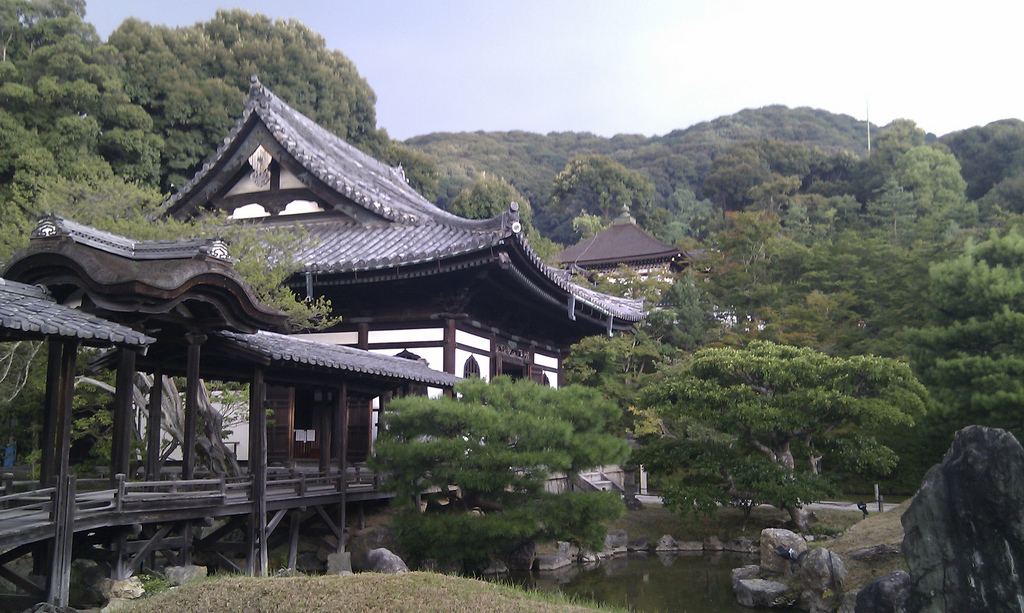
Cost: 500Y (800Y for special occasions)
Hours: 09:00 to 17:00 and later in spring and autumn when the gardens are lit up in a stunning light show
Address: 69-1Awadaguchi Sanjōbōchō
Transport: From Nishiki market it is a half hour walk to Shōren-in or go to the Shijotakakura bus stop and take the number 5 bus 6 stops to Jingu-michi bus stop
Cost: Free to enter grounds; Y500 to visit both gardens
Hours: 09:00 to 16:30 (last entry at 16.00) for temple buildings and gardens. The grounds are always open
Address: 400 Rinkachō
Transport: 5 minute walk from Shōren-in
The head temple of the popular Jodo sect of Japanese Buddhism, your first view of Chion-in temple is its majestic Sanmon gate. Dating back to the 17th century, it is the largest wooden gate in Japan and stands 24 meters tall and 50 meters wide.
Climb the huge set of stairs in front of the gate to reach the temple grounds. Once inside, you can explore the impressive temple buildings including the Miedo Hall – the main area of worship. There are also two stunning Japanese gardens to explore.
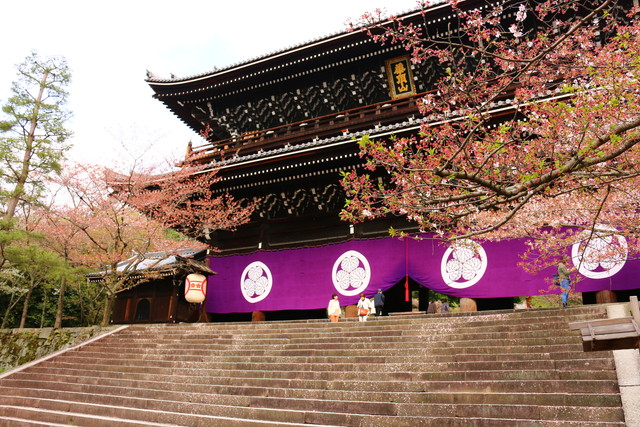
Yasaka Shrine
One of the most famous shrines in Kyoto, Yasaka Shrine (also known as Gion shrine) was built in the 14th century. The main hall is decorated with lanterns and there are many smaller shrines in the complex. In spring time the area around the temple is known for beautiful cherry blossoms. Regardless of the season you can buy tasty treats from street food vendors who operate in the grounds
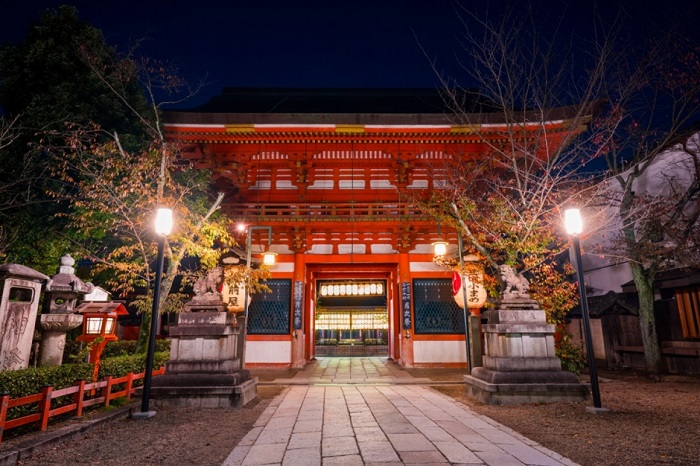
Cost: Free to enter
Hours: The grounds are always open
Address: 625 Kitagawa
Transport: 5 minute walk from Chion-in temple through pretty Maruyama park
ROUTE 2 – NIJO CASTLE
Built by the powerful shogun Tokugawa Ieyasu, Nijo Castle was built in the early 17th century in opulent style. Complete with turrets and a moat, you’ll need to pass through two huge gates before your reach the grounds of Ninomaru Palace within. Here you can visit the shogun’s residence, main hall and waiting room where several important pieces of art are displayed.
Listen for the uguisubari or nightingale floors are you make your way through the rooms. The floorboards were specially designed to squeak as people walked on them, to warn those in the castle of approaching visitors.
The castle also has wonderful gardens is a favorite spot to enjoy the cherry and plum blossoms in springtime.
Nijo castle information
Cost: From Y1000
Hours: Open daily 08:45am – 16:00pm with extended opening hours in summer. Closed 29-31 December
Address: 541 Nijo-jo-cho, Horikawa-nishi-iru
Transport: Nijo castle is a 30 minute walk or 10 minute taxi ride from Nishiki market.
17:30 GEISHA AND MAIKO SPOTTING IN GION
As the sun goes down in Kyoto, you’ll be able to experience one of the most fascinating aspects of traditional culture. At this time the famous geisha and their apprentice maiko make their way to their evening performances through the streets of Gion.
If you slip down the side streets off Hanami-Koji Dori (Gion’s main street) and wait patiently you have the best chance of seeing Kyoto’s most famous residents. Immaculately dressed and with incredible poise, their very presence makes them stand out among the yakata wearing tourists. Make sure to be there before 17:30pm.
Remember to be respectful of these ladies who are simply doing their job. They may look beautiful and almost otherworldly as they glide down the street but they are also human beings. Admire and photograph them from a distance but definitely don’t chase them. Sadly this happens a little too frequently.
18:00 DINNER OR MAIKO SHOW IN GION
After a full day exploring beautiful Kyoto, time to relax over dinner and reflect on what you saw or you can enjoy a dinner and show by a Maiko (apprentice Geisha or Geiko).
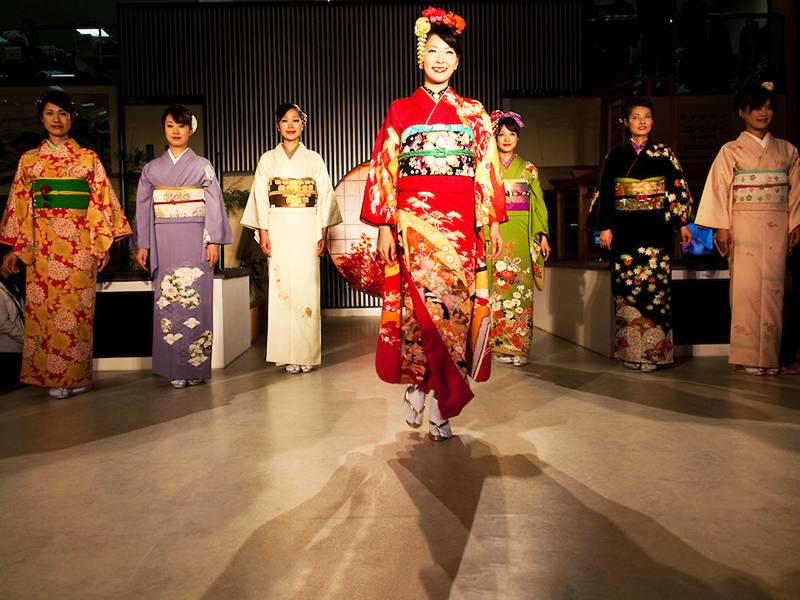
- Maiko show and din2ner – if your glimpse of the geiko and maiko in the streets of Gion was not enough then you can attend a performance by a maiko accompanied by a traditional kaiseki style dinner. There are a few of these experiences on the market however what we like about this one is that you’re able to interact with the maiko and ask questions. You may even be invited to participate in a drinking game Performances start at 18:00pm
- Casual ramen dinner – Ramen Non [ 59 Kameichō, Higashiyama-ku] Japan if you love ramen then this tiny restaurant in Gion is sure to be a hit. We loved cosy Ramen Non where the servings are generous and very tasty. Choose between salt or soy sauce ramen base and there is also fried chicken if you’re still hungry
Note – closed on Tuesdays, closes 20:30pm - Kaiseki dinner – Gion Hanaski [website] – multi-course set menu dinner featuring local produce and dishes. Expect beautifully presented seafood, soup, meat and vegetable dishes
See next: EXPLORE KYOTO WITH 2-DAY ITINERARY (DAY 1)






Add Comment